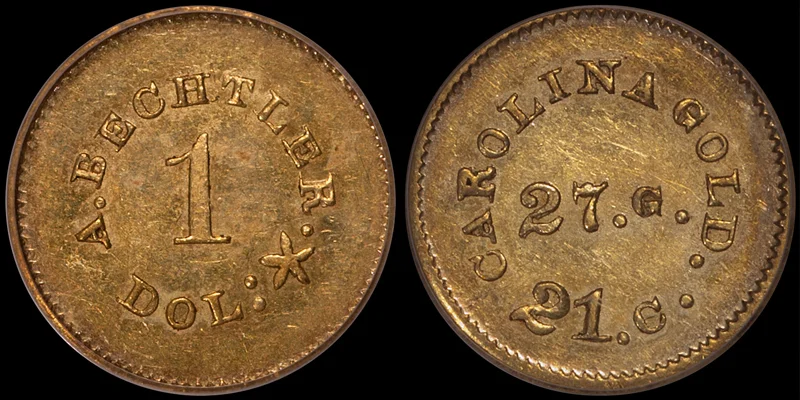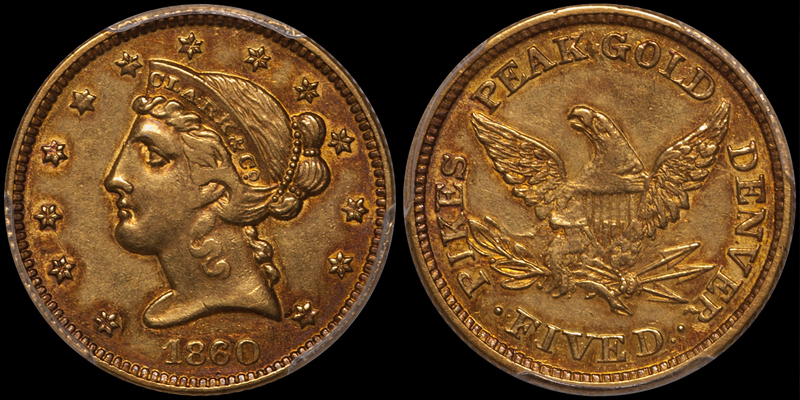Dabbling in Territorial and Private Gold Coinage
/You may—or may not—have noticed that my firm has been far more active in selling Territorial gold coinage in the last year than in the past. While I’m not ready to become a major player in this area, my interest has been piqued and I am offering some interesting coins in an attempt to discern what sells—and what doesn’t—in this niche market.
1849 Mormon $2.50 PCGS EF40
I have avoided Territorial gold in the past for a number of reasons. The foremost is the fact that many of the coins in third-party holders are very low-end. This includes coins which have been repaired, harshly processed or which are just not up to typical DWN quality. Another reason is that this market is far less transparent than Federal gold. By this, I mean that it is much harder to figure values for Territorial coins as there is no standard price guide and there is so much of a swing in quality for most issues.
Another reason why I have avoided Territorial gold until recently is due to a lack of basic information available to the collector. The last reference book published on these coins was back in the early 1980s, and there is no standardized way in which to collect the series. With, say, Dahlonega gold, it is pretty easy to decide how to collect; with Territorial it is much more complex.
1852 $10.00 Assay, PCGS MS62+ CAC
So what has occurred to get me to change my mind? A few things. First, I find these coins endlessly fascinating from an historical perspective and this compels me to add them to the DWN basket. Secondly, I think really choice Territorials are good value at current levels. Many of the more readily available issues are off 10-30% in price from market highs, and this makes them an intriguing value. Thirdly, the protection of buying coins which are PCGS/CAC and vetted by me insures that the collector is receiving a nice coin for the grade.
I’d like to make a few brief suggestions of ways to collect Territorials. As this is a short blog (and not an in-depth research article), I’m just going to touch on a few items. Based on the response I get to this blog, I will consider writing far more in-depth articles in the coming months.
1. As Collection “Augmenters”
Let’s say you are a collector of Charlotte or Dahlonega gold. A natural augmentation to your collection would be Bechtler issues from either North Carolina or Georgia.
A Bechtler $1.00 PCGS MS62 CAC
The Bechtler mint was in operation from 1830 through 1852 and it struck large quantities of gold dollars, quarter eagles, and half eagles. The primary minters were Christopher Bechtler and August Bechtler. Gold dollars were struck only with a North Carolina designation, so these will appeal to Charlotte collectors. It is possible to obtain a nice AU example of the 28 or the 30 grain dollar varieties for around $3,000-5,000. Examples exist with excellent color and a choice piece seems like a natural augmentation for a set of Charlotte gold dollars. A slightly more advanced collection might include both a C. Bechtler and an A. Bechtler issue from North Carolina.
Quarter eagles exist with both North Carolina and Georgia designations. These are considerably rarer than gold dollar counterparts, and a nice AU example of either issue is likely to cost in the $15,000-20,000 range. These are very hard to locate with original color and surfaces but when nice coins are available, they make great augmentations to a date set of either Charlotte or Dahlonega quarter eagles. Only Christopher Bechtler produced this denomination.
1834 C. Bechtler PCGS AU53 CAC
Half eagles struck by Christopher Bechtler exist from North Carolina and Georgia. These range from reasonably available to very rare based on the design type. Nice AU examples of the more available types should be available in the $10,000-15,000 range. August Bechtler half eagles will appeal to the Charlotte half eagle collector.
If you are a collector of double eagles, there are a number of issues which would augment a set of Federal coins. These include the 1852 Moffat/Humbert $20, the 1853 US Assay Office of Gold $20, the 1853 US Assay/Moffat $20, the 1855 Wass, Molitor $20, and the 1854 and 1855 Kellogg $20s. None of these are impossibly rare or expensive and with some care and patience, a set of these six issues could be assembled.
2. By State or Territory
In addition to the North Carolina and Georgia issues mentioned above, other Territorial issues which appeal to specific states include the 1849 Oregon half eagle (this design also exists as a $10 but these are very rare), the numerous issues struck by the Mormons from 1849 through 1860 (these, of course, relate to the future state of Utah), and the various Colorado gold pieces struck by the firm of Clark, Gruber & Co. in 1860 and 1861.
1860 Clark Gruber $5.00 PCGS AU55 CAC
Specializing in these issues is an expensive proposition as there are many rarities but the collector can take a few price-saving shortcuts. As an example, instead of purchasing all six of the issues made by the Mormons (this includes the 1849 $10 and $20 which are very rare and very expensive) why not, as an alternative, assemble a three-coin set featuring the three half eagles from these coiners: the 1849, 1850, and 1860?
3. By Denomination
The two denominations which were struck with the greatest frequency by Territorial coins were half eagles and double eagles. If you are a specialist in either of these series, it is an interesting side project to fill in some gaps with private mint issues.
1849 Norris Gregg Norris $5.00, Reeded Edge, NGC AU55
A half eagle set can include a Bechtler issue, an 1849 Norris, Gregg & Norris, an 1849 or an 1850 Moffat, an 1852 Wass, Molitor, a Mormon issue, and a Clark Gruber issue. These six issues can be purchased in nice Extremely Fine grades for around $100,000, and in About Uncirculated for around $150,000.
1854 Kellogg $20.00 PCGS AU58 CAC
The double eagle set is listed above and it consists of five (or six) different issues. This set can be assembled in Extremely Fine at an average of $10,000-15,000 per coin, and in About Uncirculated at an average of $20,000-30,000.
As I mentioned above, if there is enough demand for them, I will write a series of more in-depth articles about Territorial gold issues.
If you would like to dabble in these fascinating coins, please feel free to contact me via email at dwn@ont.com.
1849 Moffat $5.00 PCGS AU55

















